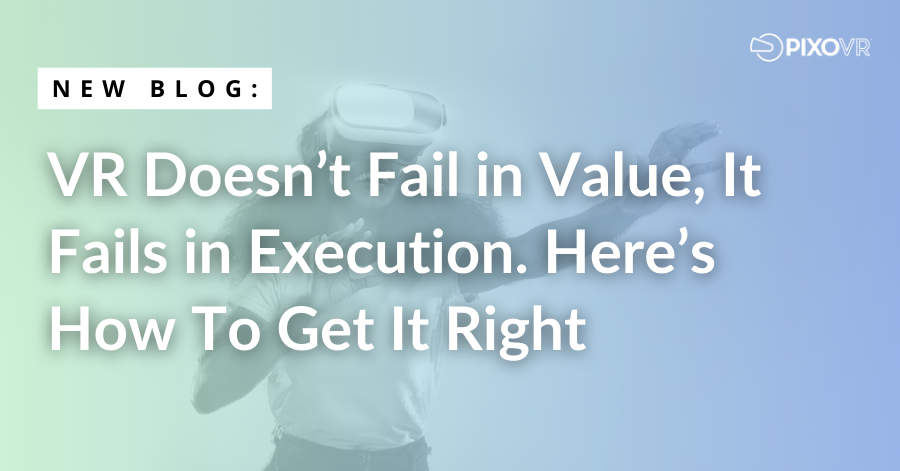For more information and to take a deeper dive into VR and how it could work for your organization, check out our FREE whitepapers, here!
Great innovation projects fail either because the technology is too new and too hard to figure out or employees responsible for execution don’t have the knowledge, resources, or incentives to execute. This has unfortunately been the path for many early VR innovation projects. But not everyone failed with VR, there have been many examples of enterprises realizing incredible value from implementing VR training.
The value is hard to ignore and corporations will quickly be left behind if they don’t begin incorporating VR into business processes. Fortunately, new technology is available that can help corporations succeed with VR training so it is a great time for innovation leaders to consider a reinvestment in VR.
To avoid failing a second time, this article highlights the seven key actions that innovation leaders need to take to ensure success with VR.
- Get IT involved
Most training managers have very little exposure to technology. They’ve perhaps used Learning Management platforms, but most instruction takes place in a classroom or via pre-recorded videos. Purchasing headsets and content, figuring out how to get the content onto the headsets, testing out use outside the company firewall, etc. are daunting challenges without the help of appropriate IT resources.
Innovation leaders need to get IT leadership involved and explain how important it is to the company to get VR working. need to get technology set up for success
- Get corporate technology
A common mistake early VR adopters make is buying the wrong headsets. Headsets that are made for gaming are not ideal for corporate use, and headsets like Oculus work in a very isolated architecture that causes IT departments major headaches.
It is critical to ensure that IT obtains headsets that are agnostic and made for corporate use cases. Pico and Vive are solid headsets for corporate use, but make sure that IT works with the VR content provider to determine the best technology for your unique environment.
Beyond headsets, there is VR software that can host the content, wirelessly deliver it to headsets, monitor usage and results, and integrate with Learning Management Systems. This investment is critical to making VR a success and to making it a part of training operations.
- Choose a strong use case
There are many use cases for VR in corporate environments. To increase the chance of success, choose a use case that has clear and measurable ROI. For many companies this is hard skill training where training costs are high due to travel or having to ship expensive equipment. This also may require custom content for proprietary processes or equipment.
Another common starter application is safety training. Here there is more standard content available so it may be a good choice if the company is worried about the investment in custom content for a pilot.
Don’t hesitate to consider the employee group being trained and the leadership as to how willing they are to try VR. It may be that gender inclusion training for office workers may be a great first choice. To make a determination, consider bringing business unit leaders together to discuss training needs and work with a VR content provider to discuss options.
- Select the right content
Now that there are standard options for many training courses, it is important to select the most effective and relevant content. Preferably content that has been already proven by other companies. Look for a VR content provider with a wide selection of content who can advise on the most effective courses.
Of course, standard content may not always be a fit. Ensure the VR content provider you work with can customize standard content to make the tweaks that fit your unique way of work. And if fully custom content is needed, be sure you are working with a provider who has experience working with similar corporations and knows how to effectively manage the process to make it as frictionless as possible.
- Get HR involved
If training reports into HR, they will of course be involved. But HR resources are critical to VR success in other ways. The internal communications team should be enlisted to help educate employees on the VR project. They need to communicate why the company is exploring VR and the value you are trying to achieve.
They can also help in rollout to build excitement and collect feedback. They should ask for testimonials from employees on their experience and share that with the company. This is especially important if an earlier project with VR failed. The more forethought and effort on this, the more successful the company will be at adopting VR and realizing value.
- Incentivize training managers
Using VR for training is completely different than how training managers deliver training today. If they have no incentive to put in the work to figure out this new technology they will revert back to the way they’ve been training.
Incentives can be monetary or they could be part of performance objectives. Tying their success to the successful launch of VR is key to the company rapidly seeing value instead of floundering.
- Create a plan beyond the pilot
VR isn’t just a passing fad to test out. It has clearly been proven to be a highly effective addition to corporate training programs. Innovation leaders need to push for planning to go beyond pilot applications and to consider the phases of rolling out VR training to more employees and more use cases. [Here’s a great guide for this].
Having a long term plan to continue to grow and mature with VR training use cases provides a path for the company to follow. Add clear milestones and tie them into performance objectives so that the company can expand value.
VR is here to stay. It’s time to figure it out before the competition.
VR isn’t going away. From training to the Metaverse, VR has a place in business. Use cases will continue to grow rapidly as adults realize the value of virtual reality beyond video games. That means that the most important investment and effort from corporate innovation needs to be focused toward VR.
And it is a race. The competition is making leaps with VR (see examples here). The key to winning is to bring the right resources and technology together to bring early use cases to value.
Need help getting VR right? PIXO VR can help. Click here to arrange a meeting with a VR expert.


Leave a Reply
You must be logged in to post a comment.